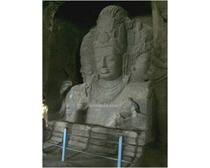The rock sculptures of Elephanta beautifully depict the historical and spiritual essence of India. Explore some interesting and fun facts about Elephanta Caves, Mumbai.
Facts About Elephanta Caves
Elephanta Caves, located in the vicinity of Mumbai - the Financial Capital of India, boasts of being an important cultural and historical site. The caves are located in the Gharapuri Island, which was renamed as 'Elephanta Island' by the Portuguese. There is temple inside the cave, which is dedicated to Lord Shiva. The complex of Elephanta Caves has a collection of shrines, inner cells, grand halls and porticos that are placed in such a way that they bring life to the rock architecture of India. It is filled with some exquisitely designed sculptures of Hindu Gods and Goddesses. Explore some interesting and fun facts about the Elephanta Caves of Mumbai. 

Interesting & Fun Facts about Elephanta Caves
- In 1987, Elephanta Caves were designated a UNESCO World Heritage Site.
- The island on which Elephanta Caves are sited was originally called Gharapuri. It was the Portuguese who renamed it as Elephanta, after they found a large stone elephant near their landing place.
- Elephanta Caves are thought to date back to time of the Silhara Kings.
- There are legends that suggest that the great warrior Prince of Chalukya Dynasty - Pulkesin ll built the Lord Shiva shrine, to celebrate his victory.
- The rock-cut temple complex covers an area of 60,000 sq ft (5,600 m2), consisting of a main chamber, 2 lateral chambers, courtyards and subsidiary shrines.
- Elephanta Caves are hewn from solid rock.
- Most of the sculptures inside the caves were defaced by the Portuguese, who used them for target practice, in the 17th century.
- The most important sculpture inside the Elephanta Caves is that of Trimurti Sadasiva, carved in relief, sited at the end of the N-S axis. The image, 20 ft in height, is that of the three headed-Lord, representing Panchamukha Shiva.
- One of the sculptures in the caves depicts Lord Shiva bringing the Ganges River down to Earth, letting it trickle through his matted hair.
- At Elephanta Caves, Lord Shiva is also depicted as Yogisvara - Lord of Yogis, seated on a lotus, and as Shiva Nataraja, the many-armed cosmic dancer.
- There are seven cave excavations, dating back to 6th-7th centuries A.D that form a part of Elephanta Cave complex.
- Cave 1, representing the evolved Brahmanical rock-cut architecture, is the most impressive cave on Elephanta Island.
- Elephanta Caves are open for public viewing from 9 am to 5 pm on all days of the week, except Monday.


See also
More from iloveindia.com
- Home Remedies | Ayurveda | Vastu | Yoga | Feng Shui | Tattoos | Fitness | Garden | Nutrition | Parenting | Bikes | Cars | Baby Care | Indian Weddings | Festivals | Party ideas | Horoscope 2015 | Pets | Finance | Figures of Speech | Hotels in India : Delhi | Hyderabad | Chennai | Mumbai | Kolkata | Bangalore | Ahmedabad | Jaipur
- Contact Us Careers Disclaimer Privacy Policy Advertise With Us Lifestyle Sitemap Copyright iloveindia.com. All Rights Reserved.







